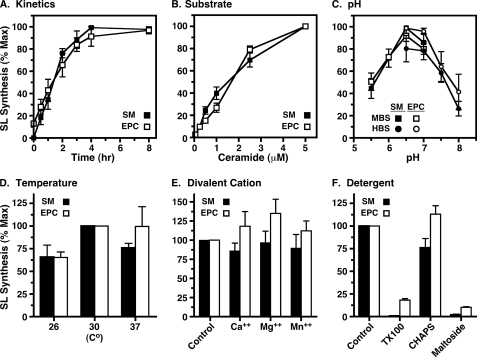FIGURE 3.
Optimization of cell-free enzymatic parameters. Formation of NBD-SM (black symbols and bars) and NBD-EPC (open symbols and bars) were used to optimize enzyme assay conditions for TbSLS4 synthesized in the cell-free system. Unless specifically varied, reaction conditions in all cases were 4 h at 30 °C in MBS, pH 6.5, with 0.25 μm NBD-ceramide. Fluorescent products were extracted and analyzed by TLC as in Fig. 2. SM and EPC products were individually quantified by phosphorimaging and normalized to maximum production (A–C) or to standard control conditions (D–F). All assays were performed in triplicate, and results are presented as mean ± S.E. A, kinetics of product formation. B, NBD-ceramide substrate dependence. C, pH dependence using MES (MBS, pKa of 6.15) or HEPES (HBS, pKa of 7.55) buffering agent. D, temperature dependence. E, effect of 10 mm CaCl2, MgCl2, or MnCl2. Note that under standard buffer conditions all reactions contain 1 mm EDTA. F, effect of detergents: Triton X-100, 0.1% (v/v); CHAPS, 0.1% (w/v); n-dodecyl-maltoside, 0.1% (w/v). The detergent:phospholipid molar ratios for these assays were Triton X-100 (TX100), 2.8; CHAPS, 2.7; and n-dodecyl-maltoside, 3.3.

